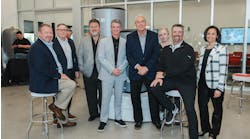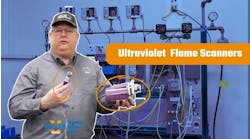BUFFALO, N.Y. — John W. Danforth Co. has won a long-term contract changing out the heating systems in 77 buildings for the Buffalo Municipal Housing Authority. It's two contracts, actually, one a performance contract with Seimens for the heating modules and the second a re-piping contract with the BMHA.
Danforth, ranked No. 34 in CONTRACTOR's 2005 Book of Giants (May, pg. 28) with revenues of more than $100 million, used its enormous expertise to create a unique solution that's still competitively priced.
The buildings in the 43-acre project house 650 apartments that have been heated by a central steam plant since construction in the 1940s. The lack of efficiency and constant repairs convinced the city of Buffalo that it was time for an overhaul.
The Danforth solution for the BMHA project was to build identical mechanical rooms in its wellequipped fabrication shop. Steel framed mechanical rooms dubbed "skids," measuring 8 ft. by 8 ft. by 10 ft., were designed using state-of-the-art CADD software and constructed in such a way to be easily picked up and trucked to the site.
Each prefabricated mechanical room is equipped with multiple gas-fired Weil-McLain Ultra modulating boilers, an indirect-fired Weil-McLain Ultra Plus water tank and Bell & Gossett pumps. The skid is pre-piped using Viega ProPress and ProPress G Systems.
So far Danforth has used 197 boilers that are 93% to 98% efficient, depending on the outdoor reset temperature, and 78 Weil-McLain domestic hot water tanks.
The problem, explained Danforth Vice President Robert Beck, is that 55 of the buildings had no mechanical space, although Danforth is using the mechanical rooms in the other 22. The solution is to attach a mechanical room to each building.
The buildings are low-rise brick structures housing from six to 12 apartments. The general contractor fabricated colored concrete, stamped to look like brick to match the buildings, into 9-ft.-by-12-ft. "doghouses."
Danforth fabricated and painted tube steel frames, mounted multiple Ultra boilers with PVC exhaust and air intakes, primary, secondary and backup pumps, and Type L copper piping joined with ProPress joints. More than 200 joints are on each skid, Beck noted.
"We have been using the ProPress System for over five years," said Kevin Reilly, CEO of employee-owned Danforth.
The skids were assembled in Danforth's piping shop, then transported to its sheet metal shop that has extra space. There the electrician set his wiring and junction boxes, and the insulator insulated the skids.
Rigger Hohl Industrial picked up the skids and trucked them on flatbeds. Hohl also ran the 40-ton crane at the site, dropping the skids into the doghouses, whereupon the GC finished the roofs.
The primary-secondary piping allows multiple temperatures in different zones in the same system, said Ed Cudney, Danforth's design/build manager. If there's a call for domestic hot water that needs 180°F water, but it's 50°F outside and outdoor reset control is only calling for 140°F, the DHW control will override it and send all the capacity into the indirect tank. It will take about 15 minutes to bring the tank up to temperature, Cudney said, and the occupants won't notice any space temperature change.
The team left the existing steam radiators although it removed the cartridges from the steam traps so the water could flow through. The team kept most of the radiator valves in service, said Project Manager Mike Bement. The valves are Taco and Honeywell Braukmann. Danforth changed the cartridges for more accurate heat control. The contractor replaced the handful of broken radiator valves with Honeywell Braukmann, Cudney said, because the owner was happy with the past performance of the Braukmann valves.
Bement teed off the radiators and installed B&G manual air vents for system startup and automatic Hoffman air vents for continuous purging. Danforth re-piped the condensate return lines into larger diameters needed for a hot water return.
Danforth replaced all horizontal piping in basements as far as the elbow to the riser, Bement said. Cudney noted that Danforth went out on a limb and started some of the re-piping before it had a contract with the BMHA. This helped the contractor develop a more definitive scope of work because it found considerable scaling in the old pipe.
"After we took pipe samples from the buildings, we decided to do a wholesale change rather than take a chance," Bement said. Danforth installed 44,000 ft. of pipe ranging from 3/4 in. to 2 1/2 in.
Because it was a public project, Danforth was required to use "Section 3" workers who had to be residents of BMHA dwellings for 25% of the work. The contractor also had to hire a tenant representative from the project to act as a liaison and to get its crews into individual apartments. Beck said Danforth has been pleased with the Section 3 workers and he hopes it can use them as a feeder into United Association Local 22.
Copper is approved for gas service in New York State, and Bement and Chris Hall, the local Viega rep, persuaded National Fuel of New York to let them use the ProPress G for the gas piping. Beck credited the local Viega sales team for the training it conducted, whether it was for 20 guys or just two.
Work has slowed now that the steam plant has been turned on for the buildings that have not yet been retrofitted. Danforth is continuing some re-piping work and is still building new skids. The job is scheduled to finish next summer.

